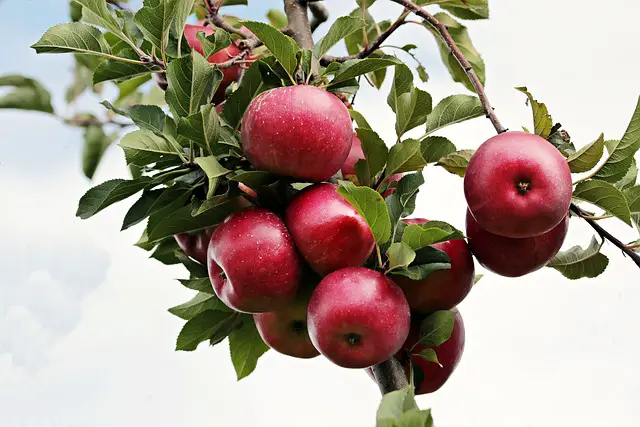
We may receive commissions from purchases made through links in this post, at no additional cost to you.
When I first decided to add espalier apple trees to my backyard, I really did my homework. I picked the perfect location (along my south-facing back fence), chose a trellis style (horizontal cordon), and researched how to prune and train them. But then it was time to choose the actual apple trees to plant.
Not all apple varieties are created equal when it comes to espalier. If you’re going to put in years of pruning and shaping, waiting patiently for the form to establish and fruit to grow, you want to make sure that you start with the right kind of tree. So what do you need to know when choosing apple trees for espalier? And which apple varieties are best suited to growing this way?
The best apple trees for espalier bear fruit on short spurs along the branches, rather than at the branch tips. Consider the climate, pollination requirements, espalier size, and harvest time when choosing an apple variety. ‘Golden Delicious’, ‘Liberty, and ‘Braeburn’ are often used for espalier.
In this article, I’ll walk through how to choose an apple variety that will work well for your situation, as well as a chart of common espalier apple varieties and their characteristics. Read on to learn what to consider before investing in not only the trees themselves, but the time and effort of setting up and maintaining an espalier.
Choosing an Apple Variety for Espalier
Spur-Bearing vs. Tip-Bearing
The first, and arguably most important, factor in choosing an espalier apple tree is whether it is spur-bearing or tip-bearing. Spur-bearing apple trees grow fruit on short, stubby branches called – you guessed it – spurs. The spurs grow in clusters along the main branches.
Spur-bearing apples are best for espalier for several reasons – for one, they’ll grow more apples on a smaller tree than tip-bearing. Clusters of spurs will grow all along the branches of an espalier, which means lots of fruit in minimal space. The spurs will produce apples for several years before they need to be pruned off to encourage new spurs to grow.
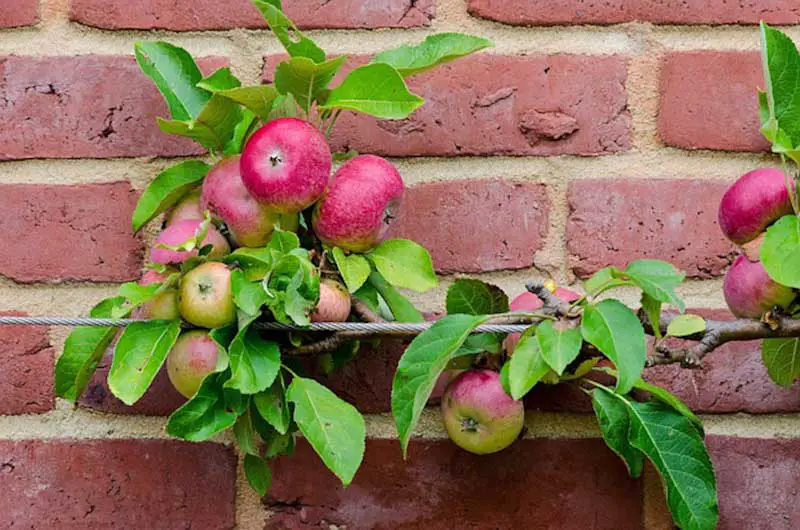
Spur-bearing apple trees also tend to grow slower and stay more compact than tip-bearing varieties – which is good news for espalier. Less vigorous growth makes it easier to prune and maintain the tree’s shape.
Tip-bearing trees, as the name suggests, produce fruit only at the tips of long branches. Partial tip-bearing apples fruit mostly at the branch ends with a few spurs along the branches. Neither type is as well-suited to espalier – fewer branches means fewer branch ends for apples to grow on.
Size and Form of Espalier
An espalier can be trained to just about any size, depending on what you are trying to accomplish in your garden. I’m growing mine between the posts of two 8-foot sections of fence, so I need the trees to stay more compact.
Watch the video below to see how set up my apple espalier:
Many espaliers are pruned to stay between 6-8 feet tall and about as wide, since the idea is to grow as much fruit as possible on a smaller tree. In general, it’s best to use a dwarf or semi-dwarf apple tree (or one grafted onto dwarf or semi-dwarf rootstock), since they will naturally grow less tall.
You can absolutely use a full-sized apple tree, especially if you are aiming for a taller espalier. Just plan on keeping those pruning shears handy to keep the vigorous growth in check, and waiting a few more years to see the first apple crop.
Trying to figure out what size tree you have? Check the plant tag for it’s expected mature height.
Mini Dwarf (5-8 feet), Dwarf (8-12 feet), Semi Dwarf (12-20 feet), Standard (20-30+ feet)
Vigor and Size of Tree
Although it’s a good idea to match the size of the tree to the height of the espalier, keep in mind the overall vigor of the tree you’ve chosen. You want the tree to grow vigorously enough to fill in the trellis in a reasonable time.
Dwarf trees tend to grow a bit slower than larger trees. It may be irritating to wait year after year for a dwarf tree to reach the next tier of the espalier. But a tree that is a too-aggressive grower (another fault of tip-bearing apple trees, in particular) may be equally frustrating to keep in check.
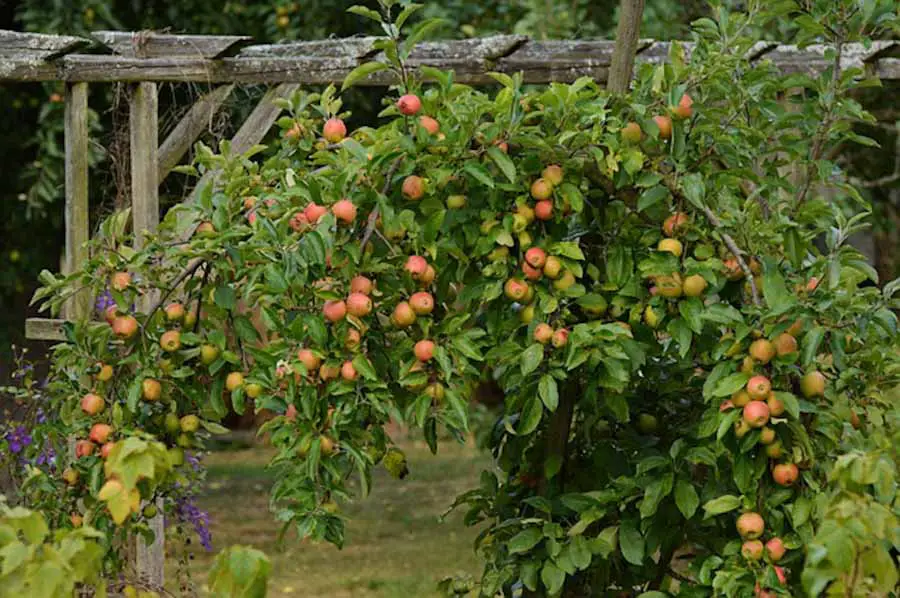
For example, ‘Golden Delicious’ (also called ‘Yellow Delicious’) is a fast-growing apple variety, growing about two feet per year. But you can purchase a dwarf ‘Golden Delicious’ apple tree that grows at a moderate rate and will only reach about 15 feet tall if left unchecked, which may be a better choice for espalier.
Dwarf apple trees tend to fruit more quickly than standard-sized trees. It may take only 2-4 years for a dwarf tree to produce fruit, while it may take up to 8 years for a larger tree. Even though you will be pruning young fruits for the first few years with an espalier (to encourage the tree to establish its form), dwarf or semi-dwarf trees will give you a harvest sooner.
As a rule of thumb, choose an apple variety that is somewhat vigorous (or will naturally want to grow somewhat larger than the trellis) for the size of espalier you’re planning. For example, for my 8-foot tall espaliers, I’ve chosen two semi-dwarf trees. They’ll grow quick enough to fill in the espalier form in a reasonable time frame, but not so vigorously that I’m endlessly pruning.
Climate
First, check the growing zone range on the plant tag (or website description) to make sure it corresponds to your zone. USDA growing zones are determined by the average low temperatures in a particular area. There are apple varieties available for just about every zone. Find your growing zone here.
Apple trees also need a certain number of chill hours (or chill units) in order to flower and fruit. The chill hours for your area are the average number of hours spent between 32° and 45°F over the winter (minus any hours over 60°F). Most apple varieties need 800 chill hours or more, but there are many cultivars that have low or medium chill-hour requirements.
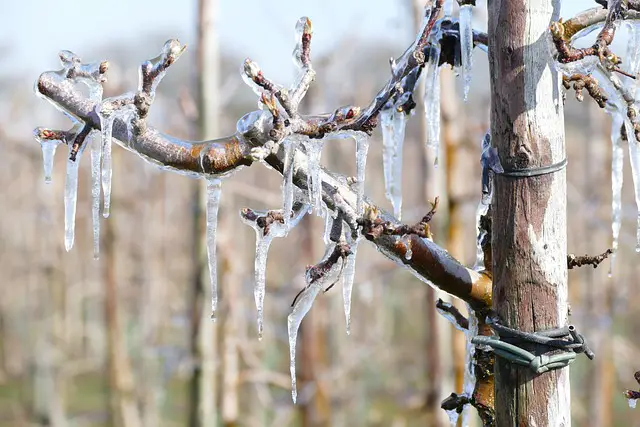
Also consider the other weather and climate conditions of your area. For example, in a hot and humid climate like mine there is high disease pressure, so a disease-resistant variety like ‘Liberty’ would be a good fit.
I live in zone 8b, so I’ve planted both ‘Anna’, which needs only 200-300 chill hours, and ‘Ein Shemer’, which requires about 350 chill hours. Both varieties are very heat tolerant, which is perfect for my hot southern climate, but still tolerate down to -10°F in the winter.
Harvest Time
Apples can be ready for harvest from June through November, depending on the variety and climate. There are varieties available for early season, mid season, and late season harvests. You may want to choose a few varieties that fruit at different times so you’ll have fresh-picked apples throughout the summer and fall.
Pollination
Some apple varieties are self-pollinating, meaning they can be pollinated from flowers on the same tree. These are great choices for backyard growers since you’ll only need one apple tree to produce a good crop. ‘Braeburn’, ‘Ein Shemer,’ and ‘Golden Delicious’ are examples of self-fruitful apples that will work for espalier.
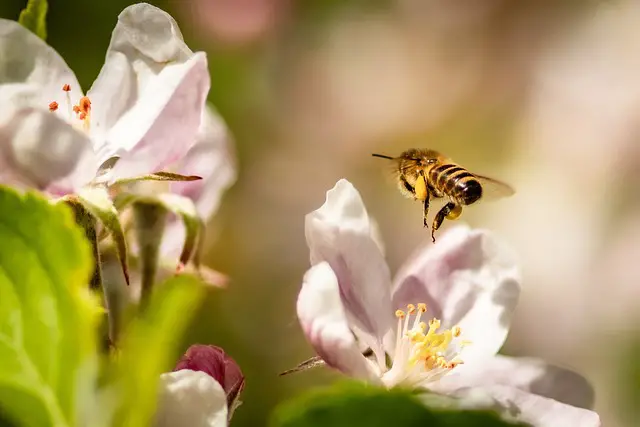
Most apple varieties do need a second tree for pollination, however. The good thing about espalier is that it doesn’t take up too much space to plant more than one. I’ve situated my two trees along consecutive sections of my back fence.
Even self-fruitful apple varieties often will produce a better harvest if a pollinizer (in this case, another apple tree) is present. If you plant two apple trees, be sure that you choose two varieties that flower around the same time to ensure pollination.
Apple Varieties for Espalier
Below is a chart of some common apple cultivars that are suitable for espalier. I’ve included information about the USDA growing zones, approximate harvest time, pollination information, and other relevant characteristics. (I haven’t included any size information as that is largely determined by what kind of rootstock the tree is grafted onto, which varies.)
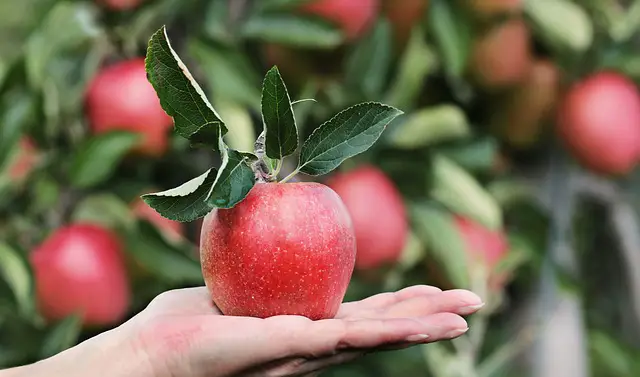
Espalier apple varieties are certainly not limited to this list! For a very extensive list (over 1000!) of spur-bearing apple varieties, most of which I’m sure would work for espalier, check out this document put together by Royal Oak Farm Orchard.
| Cultivar | Zone | Harvest | Chill Hours | Pollination | Other Info |
|---|---|---|---|---|---|
| ‘Ambrosia’ | 4-8 | September | 700 | Granny Smith, Ben Davis, CrimsonCrisp, Franklin Cider | |
| ‘Anna’ | 5-9 | June-July | 200-300 | Gala, Honeycrisp, Dorsett Golden, Winesap, Pink Lady, Golden Delicious, Ein Shemer | Can fruit in first year; sometimes two crops in one year; heat tolerant |
| Arkansas Black | 6-8 | October | 500-600 | Granny Smith, Golden Delicious | |
| ‘Ben Davis’ | 4-7 | Sept.-Oct. | not determined | Jonathan, Granny Smith, Red Delicious, Franklin Cider | |
| ‘Blushing Golden’ | 4-8 | October | 800-1500 | Jonathan, Golden Delicious, Granny Smith | |
| ‘Bountiful’ | Sept.-Oct. | Egremont Russet, Red Windsor, Golden Pippin | available in the UK; used for cooking | ||
| ‘Braeburn’ | 5-8 | October | 700 | Granny Smith, Golden Delicious, Cortland, Gala | |
| ‘Cortland’ | 4-6 | September | 800-1000 | Lodi, Freedom, Gala, Golden Russet | |
| ‘Cox’s Orange Pippin’ | September | 800 | Gold Rush, Golden Delicious, James Grieve, Winter Banana | One of the best apples for espalier | |
| ‘Crimson Crisp’ | 5-8 | September | 800-1000 | Pristine, Red Rome Beauty, Gold Rush, Honeycrisp, | Low maintenance tree |
| ‘Dabinett’ | 4-9 | October | not determined | Orange Apple, Frequin Rouge Cider, Harrison Cider | English bittersweet cider apple; needs high chill hours |
| ‘Divine’ | late summer | self fertile | Available in NZ; black spot resistant | ||
| ‘Dorset Golden’ | 5-9 | June-July | 250 | Granny Smith, Honeycrisp, Red Delicious, Anna, Gala, Winesap, McIntosh, Pink Lady, Golden Delicious | Up to two annual harvests in warm areas; heat and freeze resistant |
| ‘Egremont Russet’ | 4-9 | October | not determined | Pristine, Cherry Cox, Mott’s Pink | |
| ‘Ein Shemer’ | 6-9 | June-July | 200-350 | Self-fertile | Heat tolerant |
| ‘Empire’ | 4-7 | September | 800 | Grand Gala, Red Delicious, Orange Pippen, Lodi | |
| ‘Falstaff’ | Oct.-Nov. | Self-fertile | Available in the UK | ||
| ‘Fiesta’ | 5-8 | September | 600-800 | Partially self-fertile; Honeycrisp, Spartan, Macoun, Golden Russet | Good for hot climates |
| ‘Freedom’ | 4-8 | September | 500-600 | Cortland, Liberty, Pristine, Ben Davis | |
| ‘Gala’ | 5-8 | August | 600 | Red Delicious, Cartland, Golden Russet | |
| ‘Ginger Gold’ | 5-9 | August | 500-700 | Red Delicious, Honeycrisp, Ben Davis | Heat tolerant |
| ‘Gold Rush’ | 5-8 | October | 800 | Crimson Crisp, Red Fuji, Enterprise, Northern Spy, Red Rome | Good for warm climates |
| ‘Golden Delicious’ | 4-9 | Sept.-Oct. | 600-700 | Self-fertile | Cold hardy and heat tolerant |
| ‘Golden Russet’ | 4-8 | October | 800-1000 | Granny Smith, Pink Lady, Braeburn, Gala | |
| ‘Granny Smith’ | 5-9 | October | 400 | Red Delicious, Golden Delicious, Jonathan, Ben Davis | Heat tolerant |
| ‘Gravenstein’ | 2-9 | September | 700 | Golden Delicious, Jonathan, Red Rome Beauty, Ben Davis | Heat tolerant |
| ‘Honeycrisp’ | 3-8 | September | 800-1000 | Jonathan, Golden Delicious, Red Delicious, Macoun | |
| ‘Initial’ | 4-9 | September | 600-800 | CrimsonCrisp, Pixie Crunch, Sunrise, Empire, Jonathan, Liverty | |
| ‘James Grieve’ | June-July | Macoun, Spartan, Honeycrisp, Golden Delicious | available in the UK; acidic-sweet | ||
| ‘Jonagold’ | 4-8 | September | 800 | Jonathan, Ben Davis, CrimsonCrisp, Franklin Cider | |
| ‘Katy’ | Aug.-Sept. | 400 | Bountiful, Braeburn, Cox’s Orange Pippin, Egremont Russet, Fiesta, Golden Delicious | available in the UK; also called ‘Katya’ in Sweden; mild flavor | |
| ‘Laxton’s Superb’ | 5-8 | October | not determined | Partially self-fertile; Crimson Crisp, Pink Lady, Fortune, Dabinett | |
| ‘Liberty’ | 4-8 | Sept.-Oct. | 800 | Partially self-fertile; Gala, Cortland, Freedom, Empire | |
| ‘Macoun’ | 4-8 | September | 600 | Honeycrisp, Golden Delicious, Enterprise, Orleans Antique | Cross between McIntosh and Jersey Black |
| ‘Melrose’ | 4-9 | October | 1000 | Ellison’s Orange, Honeycrisp, Cosmic Crisp | |
| ‘Mutsu’ | 4-8 | Sept.-Oct. | 500 | Red Rome, Golden Delicious, Jonathan, Ben Davis | |
| ‘Northern Spy’ | 4-8 | October | 1000 | Ginger Gold, Red Delicious, Golden Delicious, Gold Rush | |
| ‘Pink Lady’ | 5-8 | October | 500-600 | Grand Gala, Granny Smith, Red Delicious, Ben Davis | called ‘Lady in Red’ in NZ |
| ‘Pristine’ | 4-9 | July-Aug. | not determined | Goldrush, McIntosh, Gala, Enterprise, Pixie Crunch, most crabapples | |
| ‘Queen Cox’ | 4-9 | September | 800 | Self-fertile | Hybrid from Cox’s Orange Pippin |
| ‘Red Fuji’ | 5-8 | October | 700 | Grand Gala, Granny Smith, Ben Davis, Crimson Crisp | |
| ‘Red Jonathan’ | 4-8 | September | 700-800 | Ben Davis, Ginger Gold, Freedom, Franklin Cider | |
| ‘Red Rome Beauty’ | 4-8 | Sept.-Oct. | 700 | Cox’s Orange, Wolf River, Yellow Transparent | |
| ‘Royal Empire’ | 4-7 | September | 800 | GrandGala, Red Delicious, Jonathan, Liberty | |
| ‘Rubinette’ | 4-9 | Sept.-Oct. | 600 | Honeycrisp, McIntosh, Granny Smith, Fuji, Sweet Sixteen, Pixie Crunch, Sundance, Pristine | Cross between Cox Orange Pippin and Golden Delicious |
| ‘Smokehouse’ | 4-8 | September | not determined | Golden Delicious, Empire, Ben Davis, CrimsonCrisp | |
| ‘Spartan’ | 4-9 | October | 800-1000 | Enterprise, Belmac, Bella | |
| ‘Sweet Sixteen’ | 3-6 | September | not determined | Prarie Spy, Yellow Delicious, Honeycrisp | suitable for cold climates |
| ‘Winesap’ | 5-8 | October | 500-800 | Golden Delicious, Jonathan, Red Rome Beauty | |
| ‘Winter Banana’ | 4-9 | October | 400 | Red Delicious, Golden Delicious, Zestar, Wine Crisp |

